Postcards from the field
Just before leaving for my fieldwork I received a gift from two of my colleagues to take with me: a set of colouring pencils and blank postcards. What became of these empty pages and the promise to send drawings home while I was in the field?
Themes, topics and perspectives
Just before I left for fieldwork, my friends and fellow PhD candidates Andrea Cerda-Pereira and Christoph Rippe gave me a set of colouring pencils and blank postcards, together with a request: Draw and send the cards to the Netherlands. Knowing just how hectic fieldwork experience can get, I was a bit skeptical about my chances of succeeding in this visual storytelling. Yet I did in fact manage to sit down and draw a card almost on a weekly basis. This turned out to be a fun, inspiring, and reflective process.
It was a great excuse to sit down and try to distil what had been shaping my activities over the week. Was there a particular theme that had seemed important over the past few days? And what instance could I use to represent this theme visually? Which themes lent themselves easily to visual representation, and which were harder to capture and had to rely on the accompanying text?

A postcard describing the opening of a new building.
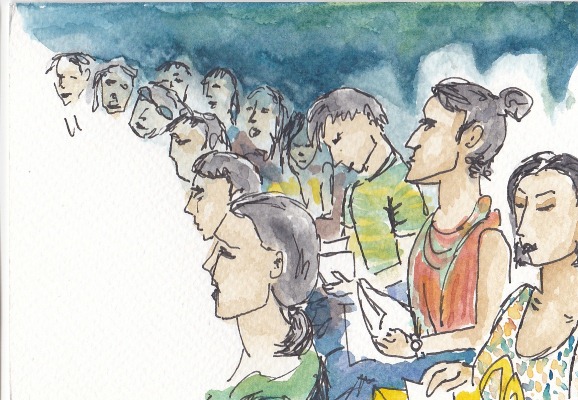
Another card brought together various points on gender issues.
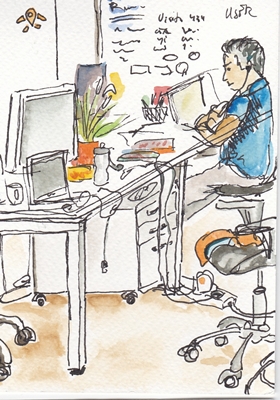
And yet another card inspired me to think about startup office spaces.
Beanbag perspective on the 'new' work environment
I drew not only postcards, but also small sketches in my fieldwork note books in the train, during meetings, or while having lunch. Here I wrote in my fieldwork notes:“I was sitting on the beanbag in the corner where the team members often sit down for a short nap, so I had a bit of a strange perspective. Drawing [the postcard] and also making the description made me think how the startup office is much more conventional than is commonly assumed [in the discussion of the new economy work environment]. Yes, it’s messy; yes, you can sleep here; yes, you have piles of snacks lying around; and, yes, you do write a lot on whiteboards. But it is also a wired office, with [ergonomically designed] office chairs [that regulate your posture]. It’s an office with desks where you come in, get your work done, and eventually leave. It’s an office where you have office utensils and a pen holder on your desk. So where is the fun? Where is the supposedly radically new, post-industrial work environment? For all the hype, this is a place where people work and do things they are not necessarily excited about.”
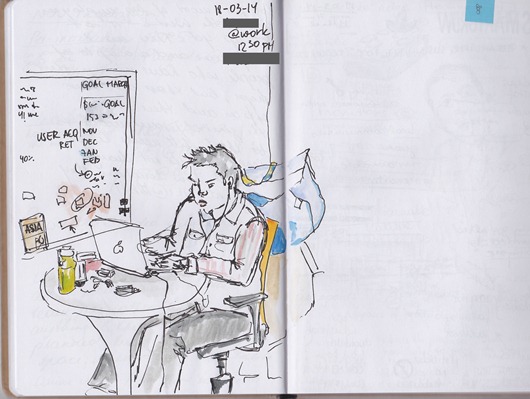
A View of a startup company office. Few unpacked boxes behind the guy working. But all his items are laid down on his temporary desk which used to be a coffee table.
A different way of engaging
I truly enjoy drawing. It is a different way of looking and seeing. It is discovery, a different mode of engaging with the environment around you. At least for a moment, drawing liberates me from the need to verbalize. From the need to find the words, match them with what I see, and pile them up one by one in hordes, typed up in straight lines of justified paragraphs. I can draw and let my thoughts wander around rather loosely as my hands are busy capturing the lines, shapes, and colours. I pay attention to things I have merely glimpsed before. I notice relationships between things I have treated separately. As I was drawing the office spaces, for example, it struck me that the way in which office workers were tangled in the electric cables, fingers glued to the keyboards, with the chairs embracing their backs like external skeletons.
Drawing also paved the way for new kinds of interaction with the people around me. For example, one of my informants decided he wanted to join my ‘drawing sessions’, which gave us opportunities to talk about what we saw around us in ways we wouldn’t have done otherwise, and possibly to get to know each other on a different level. I can recommend everyone to experiment with their observational gaze by drawing every now and then.
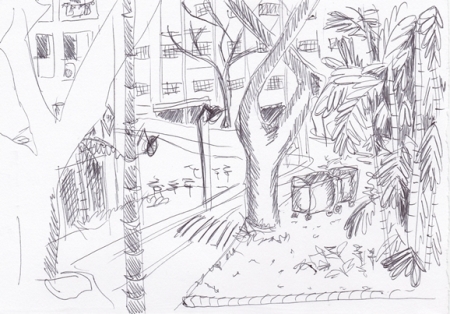
A quick sketch of my surroundings at a rather typical housing estate in Singapore as I was waiting for a meeting with an informant. I love how green Singapore is despite the b&w drawing.

A quick sketch of my fellow commuters in Singapore's metro. Everyone is glued to their smartphones
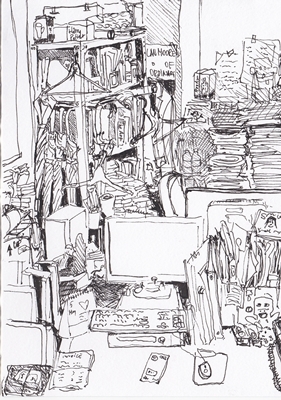
Took part in Singapore's urban sketchers monthly drawing session. In April we had a unique chance to draw at Singapore's largest book store and its offices.
But I can’t draw…?
Well, neither can I. Isn’t that the whole point? There’s no such thing as drawing well or not so well when you treat drawing as a process rather than a way to create an object. In some ways the result shows just how subjective and personal our accounts of reality are - everybody has their own style, their own lines, their own colours, their own ways of framing and seeing. Anthropologist Michael Taussig has written a beautiful book on drawing field notes. In one section he describes himself labouring over a drawing of a phantom boat rushing upriver at night somewhere in Colombia and then taking a look at his drawing: “(...) I fear all I am left with is an unsightly smudge with some yellow stain like a mustard spill. I then tell myself that the result is pitiful but the struggle worth it because I looked at colour and I looked at the night and the river like I never had before and saw what I take so for granted with new eyes. Is there any activity that so rewards failure? These are toads that become flowers.”
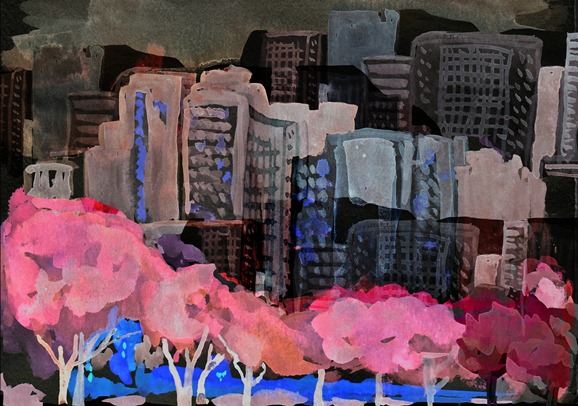
A collage of multiple water color drawings trying to capture the view from an office I often worked at. Compiled the images and manipulated the colors later when at home. Calling it “An ethnography”.
Drawing in/a conclusion
Towards the end of my stay, after a good number of postcards had travelled to the Netherlands, I received one sent my way: Andrea and Christoph had drawn each other at work in their office.
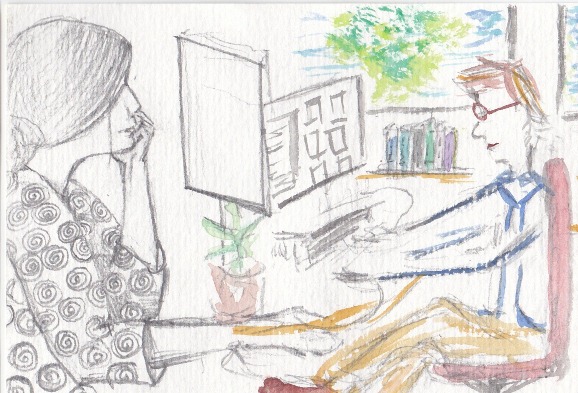
Drawing of Andrea and Cristoph.Thank you!


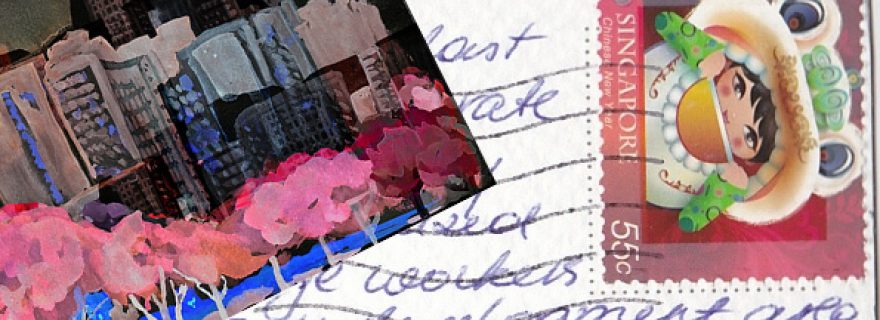
9 Comments
and eventually leave. It’s an office where you have office utensils and a pen holder on your desk? Visit us <a href="https://ensiklopedia.telkomuniversity.ac.id/cara-mudah-merangkum-video-youtube-menjadi-teks-secara-otomatis/">Telkom University</a>
Thank you again for the good words. I am glad you find this inspiring. Regarding including these drawings in the dissertation - I feel that the use of a particular medium - in this case the hand made sketches - should then also conceptually link up with the contents of the text and the argument. At this moment I haven't yet seen a way to incorporate the drawings (sleek digital graphics seem more fitting at the moment), but this might change as the dissertation slowly gains its shape.
Your drawings are so inspiring! I really appreciate how you analyze drawing as a new means for (re)connecting with others, and your own thinking/self-reflection process.
Really inspiring, thankyou!
I hope you're thinking about including drawings in your dissertation also, because you totally should! (I only have 1 drawing in mine, and my daughter made it, not me).
Thank you! I am really touched by the positive feedback this post has generated and the thought that someone might be inspired to draw as a result of this makes me :) I'll be cheering for you, Kim!
During the last month as part of a masterclass on gender and manga, I experimented with drawing a comic based on my fieldwork. Was hard but also incredibly enjoyable! And again, required very different thinking about the research material.
Hi Zane, great drawings, and very nice insights. Many write about it and few actually do it, but you did!. Nice refection on 'other ways of engagement'. As you show, drawing has a real reflective quality to it, different from the analogue narrative in text, and it enables another, more affective, way of knowing...
Dear Zane,
A great blog and great friends! I will definitely try this :) Thanks!
All best,
Kim
Zane, Lovely entry blog! I will be a frequent visitor here! Good luck!
Add a comment